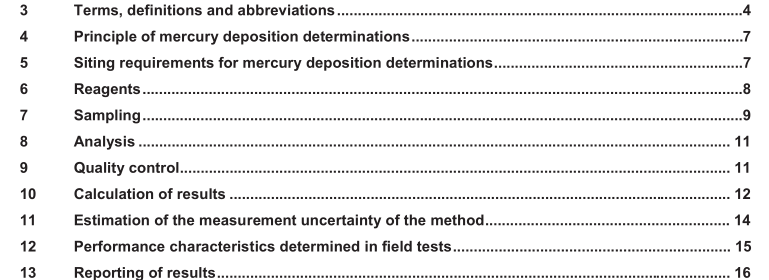EN 15853:2010 – Ambient air quality – Standard method for the determination of mercury deposition

4 Principle of mercury deposition determinations Atmospheric deposition is defined as the sum of the depositions of sedimenting particles, non-sedimenting particles and gases. Total atmospheric deposition is the sum of dry deposition and wet deposition. Bulk deposition is the sedimenting part of the atmospheric deposition. There is no method available to determine total atmospheric deposition in one measurement.
The determination of the dry deposition requires micrometeorological measurements, taking into account the turbulent atmospheric transport processes. Wet deposition and bulk deposition, however, can be estimated using suitable collectors.
This standard describes methods to determine wet deposition and bulk deposition of mercury using wet-only- and bulk collectors. The wet-only collector is designed to collect sedimenting water containing wet particles only, while the bulk collector is designed to collect all sedimenting wet and dry particles. However, since the deposition process is affected by various factors, e.g. wind speed, temperature, vegetation, surface type, etc., the wet-only collector will not catch all sedimenting wet particles while some sedimenting dry particles, non-sedimenting particles and gases will be collected. Also, the bulk collector will not catch all sedimenting particles while some non- sedimenting particles and gases will be collected. The method is divided into two main parts:
a) sampling of precipitation in the field;
b) mercury analysis in the laboratory. The precipitation sample is stabilized with hydrochloric acid and transferred to the laboratory in the collection vessel.
Mercury in the precipitation sample is oxidised using bromine monochloride. Mercury is analysed either by CVAAS or CVAFS detection.
5 Siting requirements for mercury deposition determinations The following guidelines shall be met as far as practicable (Annex III.II of Directive 2004/107/EC [10]):
a) The site chosen for sampling and measurements shall be representative of a larger area. The size of this area is determined by site characteristic (urban, industrial or rural) and the variability of the air and precipitation quality.
b) The collector shall as far as possible not be exposed to areas where unrepresentative strong winds occur like shores, cliffs and top of hills, but it shall also not be sheltered by tall trees or buildings. The flow
EN 15853:2010 – Ambient air quality – Standard method for the determination of mercury deposition